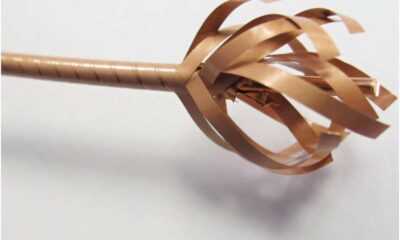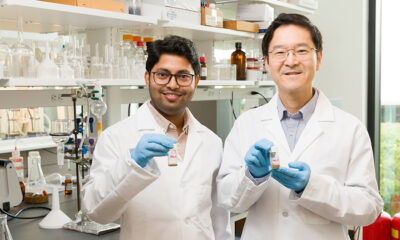Science
Innovative Cable Design Enhances Superconducting Wire Reliability

A groundbreaking new cable design has been developed by researchers at the FAMU-FSU College of Engineering and the Florida State University Center for Advanced Power Systems, in collaboration with industry partners. This innovative design aims to address the inherent flaws found in superconducting wires, which can impede the flow of electrical current.
Tiny defects within a superconducting wire often force current to navigate a longer, less efficient path. This issue has posed significant challenges for engineers and manufacturers striving for reliability in electric systems. By utilizing multiple strands of superconducting tape to create a cable, the new design minimizes the risk of failure due to these defects. When current encounters a flaw in one wire, it can seamlessly shift to a neighboring wire, ensuring continuous flow.
The research, published in Superconductor Science and Technology, promises to enhance the efficiency and affordability of superconducting wires used in electric motors and various coil applications. “By partnering with Advanced Conductor Technologies, we are not only fostering an innovative idea but also facilitating the swift transition of this technology into practical applications,” explained Sastry Pamidi, interim director of the Center for Advanced Power Systems and chair of the Department of Electrical and Computer Engineering.
Transforming Superconducting Wire Technology
The new cable design builds on previous collaborations between the researchers and Advanced Conductor Technologies, a Colorado-based company. The team developed a superconducting wire technology known as Conductor on Round Core (CORC), which has become foundational for creating superconducting coils that utilize helium gas for cooling. This approach offers greater design flexibility, as helium remains in a gaseous state over a broader temperature range than alternatives like liquid nitrogen.
CORC wires are constructed by spirally winding multiple layers of superconducting tapes. Instead of being soldered together, the tapes rely on pressure to facilitate electrical flow. This design maintains flexibility and strength, even under tension. Randomly distributed defects are less likely to cluster within a cable, allowing for a process termed “current sharing.” This mechanism enables manufacturers to utilize a greater percentage of the wire produced, reducing waste and lowering costs.
The partnership between Florida State University and industry entities has yielded significant advancements. Previous projects have integrated faculty with Advanced Conductor Technologies and SuperPower Inc., a manufacturer of second-generation high-temperature superconducting tape.
Collaboration Driving Innovation
The collaboration is supported through initiatives like the U.S. Small Business Administration’s Small Business Innovation Research and Small Business Technology Transfer programs. “Our research has a tangible impact. It aids companies in product development. Without our contributions, these companies would struggle to advance their manufacturing processes,” Pamidi stated.
Both the university and industry partners benefit from this collaboration. Companies gain access to advanced research facilities and engineering expertise to solve complex challenges. “The scientific infrastructure at Florida State University has been crucial for the development of superconducting CORC cables and wires at Advanced Conductor Technologies,” noted Danko van der Laan, president and CEO of ACT. “Our ongoing partnership has enabled us to overcome technical barriers that could have hindered our commercial success in areas such as fusion and particle acceleration.”
The implications of improving superconducting wires extend across various sectors. These wires are essential for applications in electric motors, generators, electric aircraft, medical devices, fusion reactors, data centers, and high-energy physics facilities. Superconducting wires can transmit electricity without losses, facilitating the development of more efficient machines and systems, including magnetic levitation for high-speed rail.
Despite the promise of superconducting technology, the manufacturing process often introduces defects. Traditionally, the solution involved soldering multiple segments to create a long, defect-free wire. The innovative cable design optimizes the benefits of superconducting wires while reducing production costs, making the technology more accessible.
“We are thrilled with the results of this project,” said Yifei Zhang, vice president of research and development at SuperPower. “The unique structure of CORC and the fabrication methods used in this work demonstrated that coils created with wires initially deemed defective performed comparably to those made with nearly flawless wires. This finding could significantly change how we calculate wire production yields, leading to reduced costs.”
Researchers at Florida State University are also exploring high-temperature superconducting wires that can operate with minimal resistance at temperatures up to 77 kelvins. This advancement could simplify and lower the costs of implementing superconducting technologies across various industries.
For more information on this research, refer to the study by Jeremy D. Weiss et al., titled “Demonstration of current sharing around tape defects in a low-inductance CORC® wire solenoid generating a peak magnetic field of 4.6 T at 25 K,” published in Superconductor Science and Technology on November 18, 2025.
-

 Technology4 months ago
Technology4 months agoDiscover the Top 10 Calorie Counting Apps of 2025
-

 Health2 months ago
Health2 months agoBella Hadid Shares Health Update After Treatment for Lyme Disease
-

 Health3 months ago
Health3 months agoErin Bates Shares Recovery Update Following Sepsis Complications
-

 Technology3 weeks ago
Technology3 weeks agoDiscover 2025’s Top GPUs for Exceptional 4K Gaming Performance
-

 Technology4 months ago
Technology4 months agoDiscover How to Reverse Image Search Using ChatGPT Effortlessly
-

 Technology2 months ago
Technology2 months agoElectric Moto Influencer Surronster Arrested in Tijuana
-

 Technology4 months ago
Technology4 months agoMeta Initiates $60B AI Data Center Expansion, Starting in Ohio
-

 Technology4 months ago
Technology4 months agoRecovering a Suspended TikTok Account: A Step-by-Step Guide
-

 Health4 months ago
Health4 months agoTested: Rab Firewall Mountain Jacket Survives Harsh Conditions
-

 Lifestyle4 months ago
Lifestyle4 months agoBelton Family Reunites After Daughter Survives Hill Country Floods
-

 Technology3 months ago
Technology3 months agoUncovering the Top Five Most Challenging Motorcycles to Ride
-

 Technology4 weeks ago
Technology4 weeks agoDiscover the Best Wireless Earbuds for Every Lifestyle













